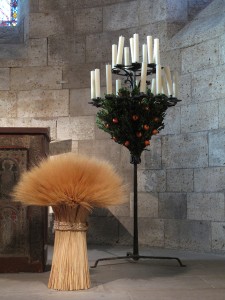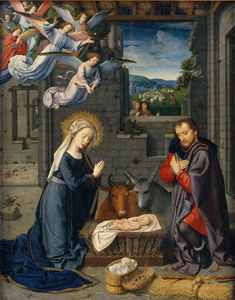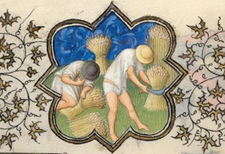Bread from Heaven
Above, left: The holiday decorations at The Cloisters are made by hand from plants linked with the celebration of Christmastide in the Middle Ages. A sheaf of wheat???an allusion to the eucharistic symbolism of the “altar-manger” and the transformation of the Christ Child into the bread of the Mass???stands near the altar frontal in Langon Chapel. Right: In the central panel of Gerard David’s triptych Nativity with Donors and Saints Jerome and Leonard, the wheat ears that fill the manger and spill from the sheaf in the foreground are shown in meticulous detail.
A strong link was made between wheat and the Nativity early in the history of Christian exegesis, based on the symbolism of the Eucharist. The identification was founded in the interpretation of such scriptural passages as John 6:41, in which Jesus identifies himself as “the bread come down from heaven.” In his homily on the Nativity, Homilia VIII in die Natalis Domini, the sixth-century Doctor of the Church, Saint Gregory the Great, translated “Bethlehem” as “house of bread” and expounded the transformation of the Christ Child from hay into wheat. These interpretations???as well as the practice of placing consecrated bread in the relic of the Holy Crib installed at the church of Santa Maria Maggiore and the liturgical manger plays that originated there and were revived and popularized by Saint Francis of Assisi???emphasized the sacramental aspect of the birth of Christ. The pictorial tradition of showing the infant Jesus lying on a heap of grain is found in representations of the Nativity from the end of the fifteenth century. As Maryan Ainsworth notes, the composition of the central panel in Gerard David’s early sixteenth-century triptych, in which Mary and Joseph adore the Christ Child, owes something to the Nativity by Hugo van Der Goes (see image) in the Gem??ldegalerie in Berlin, painted about 1480. For a list of fifteenth- and sixteenth-century Italian paintings with similar iconography, see Mirella D’Ancona Levi.
???Deirdre Larkin
Sources:
Ainsworth, Maryan W. Gerard David: Purity of Vision in an Age of Transition. New York: Metropolitan Museum of Art, 1998.
Levi D’Ancona, Mirella. The Garden of the Renaissance: Botanical Symbolism in Italian Painting. Firenze: L. S. Olschki, 1977.
Schiller, Gertrud. Iconography of Christian Art. Translated by Janet Seligman. Vol. 1. Greenwich, CT: New York Graphic Society, 1971.




